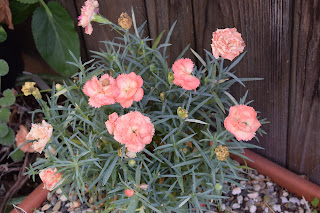As we all deal with the pandemic each in our own way, there is no doubt this will be a Thanksgiving to remember. I won't even attempt to put words to it as its effect is so individualized. I can only say for myself - "Thank goodness for my garden!" It is the one enduring constant in my life, a pleasure that also helps to keep me grounded and a reminder that Nature is Nature, even beyond our human foolishnesses.
That said, here are some recent photos from my garden. They cover the spectrum of its delights - some flowers, some foliage, some succulents, some bromeliads, some dry garden plants. Enjoy!
An updated look at my walkway bed. It is relatively dormant now, though there still are a few Agastache in bloom, plus two Monardellas, my Black lotus and two varieties of oxalis. But this bulb-filled bed has already sent up shoots for Freesia, Ipheion and Dutch iris.
My Mandevilla Apricot continues to bloom. In its third year now, the flowers are finally showing a true color.
One of my favorite Mimulus varieties, this M. Sunset offers lovely peach tones.
This may be a hard plant to ID so will say up front that it's a Strobilanthes anisophyllus.Its calling card is its dark, almost black, foliage.
Mina lobata. This flowering annual vine had a good year and as you can see, its flowers change from red to orange to yellow to white.
These are probably the last flowers on my Lepechinia bella. Such a pretty blue.
Many people are familiar with Beauty berry bushes. They are of winter interest, producing purple berries that last for months. Here's the white version - Callicarpa japonica leucocarpa.
I kept waiting for my redder-than-red Ruellia elegans to produce a bevy of flowers but alas, they've been coming out only one or two at a time.
Now well established, my Duranta repens Gold Mound is 10' high. It holds onto that lovely gold color year round.
Fall through early spring is the time for Cyclamen. Here are two varieties.
Aechmea fulgens is one of the easiest bromeliads to grow and also one of the most dependable bloomers. Here's the beginning of a flower spike, with the orange buds (bracts) eventually opening to tiny flowers. This species also features dramatic maroon-colored backsides to the leaves.
After two years of not blooming, suddenly my Luculia pinceana has produced a great many buds. Here is one cluster, about to open to pale pink flowers that are heavily perfumed.
Chamelaucium x verticordia. It's still young and growing but this cross will eventually produce small pink flowers with deeper pink centers. I like it as much for the wispy foliage.
I've had hit-and-miss success with passifloras but this one, P. Oaklandii, has been a roaring success. It now has completely smothered the top of my backyard apple tree. Which I don't mind as I don't harvest the tasteless crabby fruit.
I finally have a photo that shows the true color of this Dianthus variety's flowers. Sort of a salmon pink.
It's late but my Tweedia is producing its last clutch of robin's egg blue flowers.
Though Magnolias are of course grown for their flowers some, including this M. Butterflies, show off very colorful fall foliage right before the leaves drop.
One of the more decorative Justicias, this J. 'Fruit Salad' has bright chartreuse bracts and contrasting red flowers. It took awhile - so long I wasn't certain it would bloom - but it has been blooming nonstop since late September.
Speaking of robin's egg blue flowers, my Salvia bullulata Pale Form has scads of them this fall. Though they are possibly the smallest flowers on any salvia, they make up for it with that exquisite color.
Sometimes giving a plant a 'haircut' (cutting it back almost to the ground) can trigger the plant to start over and even rebloom in the same year. That's been true for this Echinacea Yellow Sombrero.
A large offshoot of my Aechmea fulgens snapped off so I've moved it over to the sunny crevice of this fir tree. So far so good.
To my great surprise (and delight) my newly planted Agave tricolor has already produced two offshoots. Normally Agaves are slow growers and thus slow to pup.
Though no flowers in this photo, I took it to show the clumps of Babiana leaves that are already up. One of the earliest South African bulbs to appear and then bloom, it's distinguished by its pleated leaves.
Salvia regla Huntington. This late blooming sage has especially long tubular flowers. It also features textured leaves which exude a strong woodsy scent.










































